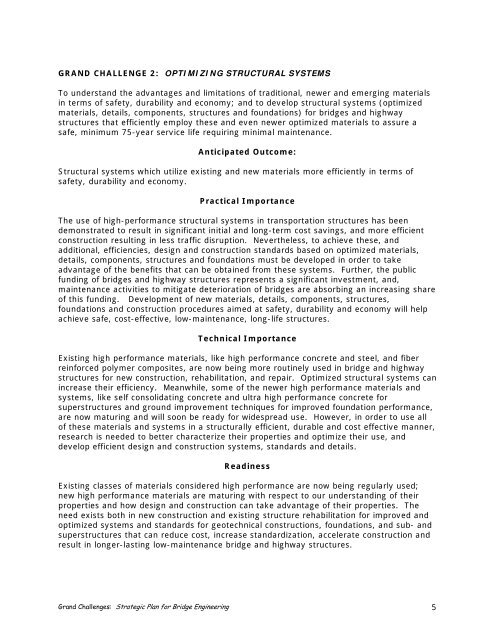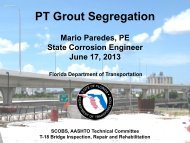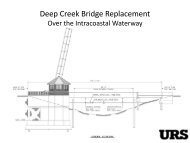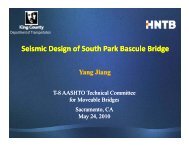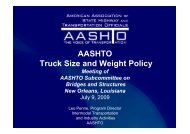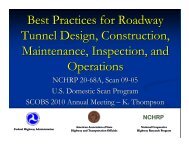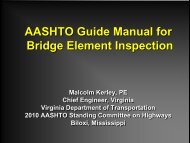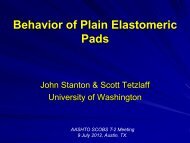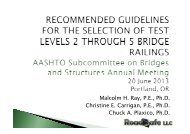A Strategic Plan for Bridge Engineering - AASHTO - Subcommittee ...
A Strategic Plan for Bridge Engineering - AASHTO - Subcommittee ...
A Strategic Plan for Bridge Engineering - AASHTO - Subcommittee ...
- No tags were found...
You also want an ePaper? Increase the reach of your titles
YUMPU automatically turns print PDFs into web optimized ePapers that Google loves.
GRAND CHALLENGE 2: OPTIMIZING STRUCTURAL SYSTEMSTo understand the advantages and limitations of traditional, newer and emerging materialsin terms of safety, durability and economy; and to develop structural systems (optimizedmaterials, details, components, structures and foundations) <strong>for</strong> bridges and highwaystructures that efficiently employ these and even newer optimized materials to assure asafe, minimum 75-year service life requiring minimal maintenance.Anticipated Outcome:Structural systems which utilize existing and new materials more efficiently in terms ofsafety, durability and economy.Practical ImportanceThe use of high-per<strong>for</strong>mance structural systems in transportation structures has beendemonstrated to result in significant initial and long-term cost savings, and more efficientconstruction resulting in less traffic disruption. Nevertheless, to achieve these, andadditional, efficiencies, design and construction standards based on optimized materials,details, components, structures and foundations must be developed in order to takeadvantage of the benefits that can be obtained from these systems. Further, the publicfunding of bridges and highway structures represents a significant investment, and,maintenance activities to mitigate deterioration of bridges are absorbing an increasing shareof this funding. Development of new materials, details, components, structures,foundations and construction procedures aimed at safety, durability and economy will helpachieve safe, cost-effective, low-maintenance, long-life structures.Technical ImportanceExisting high per<strong>for</strong>mance materials, like high per<strong>for</strong>mance concrete and steel, and fiberrein<strong>for</strong>ced polymer composites, are now being more routinely used in bridge and highwaystructures <strong>for</strong> new construction, rehabilitation, and repair. Optimized structural systems canincrease their efficiency. Meanwhile, some of the newer high per<strong>for</strong>mance materials andsystems, like self consolidating concrete and ultra high per<strong>for</strong>mance concrete <strong>for</strong>superstructures and ground improvement techniques <strong>for</strong> improved foundation per<strong>for</strong>mance,are now maturing and will soon be ready <strong>for</strong> widespread use. However, in order to use allof these materials and systems in a structurally efficient, durable and cost effective manner,research is needed to better characterize their properties and optimize their use, anddevelop efficient design and construction systems, standards and details.ReadinessExisting classes of materials considered high per<strong>for</strong>mance are now being regularly used;new high per<strong>for</strong>mance materials are maturing with respect to our understanding of theirproperties and how design and construction can take advantage of their properties. Theneed exists both in new construction and existing structure rehabilitation <strong>for</strong> improved andoptimized systems and standards <strong>for</strong> geotechnical constructions, foundations, and sub- andsuperstructures that can reduce cost, increase standardization, accelerate construction andresult in longer-lasting low-maintenance bridge and highway structures.Grand Challenges: <strong>Strategic</strong> <strong>Plan</strong> <strong>for</strong> <strong>Bridge</strong> <strong>Engineering</strong> 5


